Chapter 6: Distress and emergency
In this chapter you will ….
- learn about the implementation of the ISM-code and its purpose
- get an understanding of classes of fire and different fire fighting systems
- learn about abandon ship drills and fire drills
- learn internal communication in emergency situations
Know the law

The Convention of Standards of Training, Certification and Watchkeeping for Seafarers, or STCW, ensures that all seafarers, regardless of country or nationality, are educated and trained according to the same standard. STCW specifies the qualifications of standards for training and certification, including basic safety training required for officers as per the amended 2010 Convention/STCW. STCW ensures that all seafarers are educated and trained according to the same standard regardless of country or nationality.
When in an emergency, good procedures and unambiguous communication is vital. Distress and emergency situations demand the seafarer to know and understand a set of rules and procedures. Safety is emphasised and issued both in education and training and through regulations, codes and laws, and as a seafarer, there are numerous procedures, laws and regulations you are obliged to know, understand and comply with.

History forever changes in the wake of a terrible accident or disaster. A tragedy can often spark changes to rules and regulations in an effort to prevent future unwanted events.
A well-known example is when, in November 1913 to January 1914, over 100 representatives from various maritime nations gathered at a conference in London to address safety issues in response to the tragic sinking of the RMS Titanic two years earlier. After seven weeks of work, the outcome, The Convention for the Safety of Life at SEA, or SOLAS, was ready to be signed.
Download this file to learn more about the relationship between SOLAS and Titanic.
SOLAS Chapter III, Regulation 19 deals with emergency training and drills. It requires all seafarers to be familiar with safety installations and on-board instructions and records. This section of the book discusses the importance of SOLAS Chapter III by emphasizing the necessity of English in training for emergency situations.
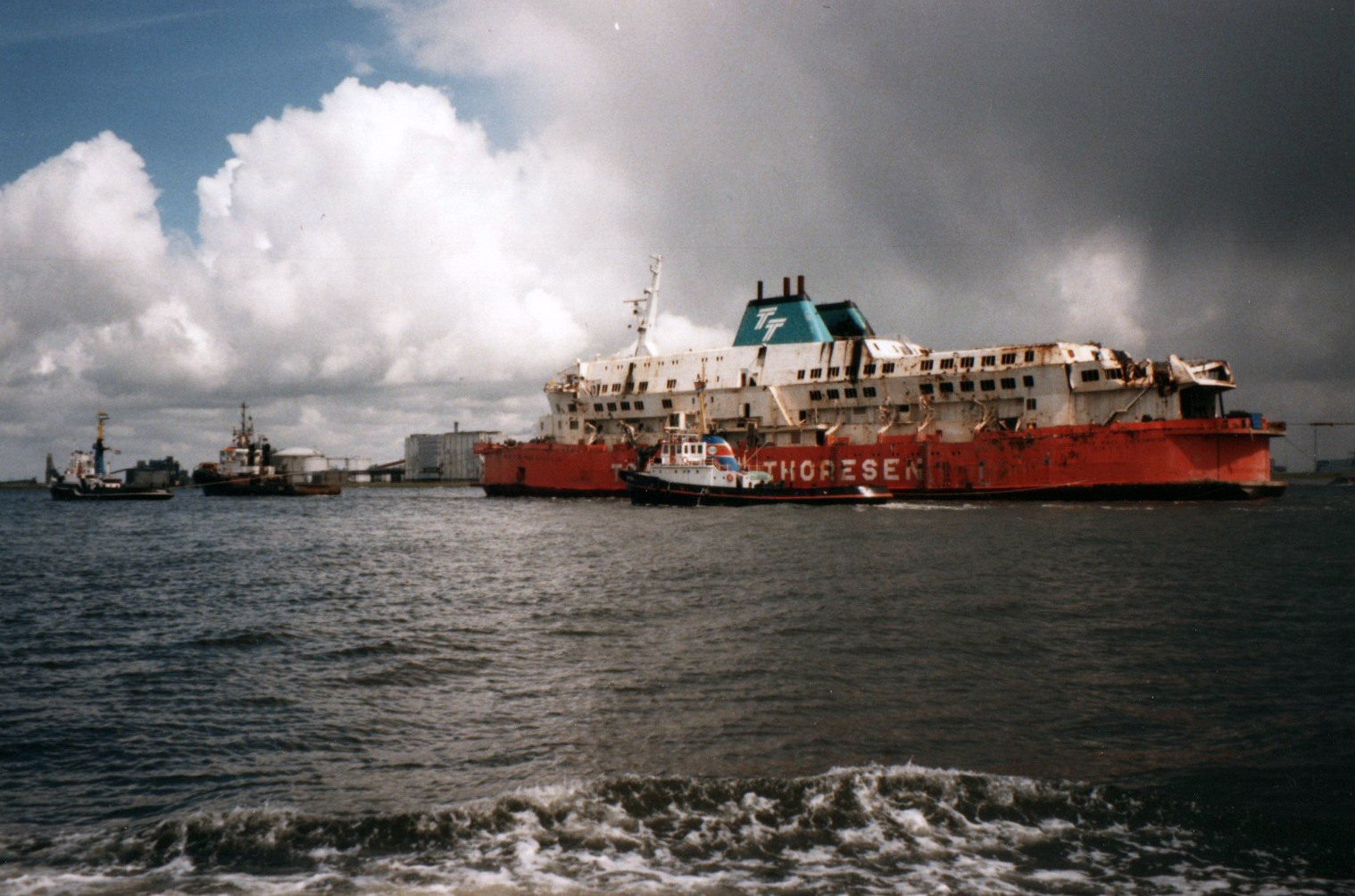
In the aftermath of the capsizing of the Herald of the Free Enterprise in 1987, a paradigm shift in the maritime safety administration arose, and the International Safety Management Code, ISM, was adopted and incorporated into Chapter IX of SOLAS; Management for the safe operations of ships in 1994. By 2002, almost all of the international shipping community was required to comply with the ISM code. The ISM code’s objectives are to ”[…] ensure safety at sea, prevention of human injury or loss of life, and avoidance of damage to the environment, in particular to the marine environment, and to property.”
The ISM Code is ratified through Norwegian law through the Ship Safety and Security Act in the Regulations on a safety management system for Norwegian ships and mobile offshore units. As you can see from the excerpt from the Regulation below, the Code and Regulations list safety management objectives for individual companies to provide, asses, improve and comply with:
1.2. Objectives
1.2.1. The objectives of the Code are to ensure safety at sea, prevention of human injury or loss of life, and avoidance of damage to the environment, in particular, to the marine environment, and to property.
1.2.2. Safety management objectives of the company should, inter alia:
1.2.2.1. provide for safe practices in ship operation and a safe working environment;
1.2.2.2. assess all identified risks to its ships, personnel and the environment and establish appropriate safeguards; and
1.2.2.3. continuously improve safety management skills of personnel ashore and aboard ships, including preparing for emergencies related both to safety and environmental protection.
1.2.3.The safety management system should ensure:
1.2.3.1. compliance with mandatory rules and regulations; and
1.2.3.2. that applicable codes, guidelines and standards recommended by the organisation, administrations, classification societies and maritime industry organisations are taken into account .
As stated in 1.2.3, a safety management system must ensure that rules, regulations, codes and standards are complied with and taken into account. The Norwegian Maritime Authority further elaborates upon this safety management system:
1.4. Functional requirements for a safety management system (SMS)
Every company should develop, implement and maintain a safety management system (SMS) which includes the following functional requirements:
1.4.1. a safety and environmental protection policy;
1.4.2. instructions and procedures to ensure safe operation of ships and protection of the environment in compliance with relevant international and flag State legislation;
1.4.3. defined levels of authority and lines of communication between, and amongst, shore and shipboard personnel;
1.4.4. procedures for reporting accidents and non-conformities with the provisions of this Code;
1.4.5. procedures to prepare for and respond to emergency situations; and
1.4.6. procedures for internal audits and management reviews (ibid.).
The six bullet points above may seem like an unnecessary addition to all the different procedures, instructions and pointless red-tape, bureaucratic policies already in place for those working at sea. When the ISM-code and consequently the Safety Management System (SMS) entered into force, many shipping companies hired consultants to develop an SMS. This resulted in a number of instructions and procedures that many seafarers aboard experienced as an extra burden in an already hectic workday. These newly implemented instructions and procedures, written in a language which is difficult to understand, stopped being a helpful guide for maintaining on-board safety, becoming, rather, an added daily stress. Therefore, many of the shipping companies have been and are currently working on making better, easier and more effective procedures, as we will see later in this section.
Exercises
How does
- SOLAS implement safety and safety training?
- STCW implement safety and safety training?
- ISM regulate safety and safety training?
- Norwegian Law regulate safety and safety training?
- Your curriculum implement safety and safety training?
In case of emergency
Through your work experience and training so far, you are well aware of the importance of knowing what to do and your responsibility in an emergency situation. Proper and approved training in theoretical and practical firefighting, gained through both your education and previous work experience at sea, is essential. Knowing the basic theory of fire as well as being able to read and understand the law in force, are also necessary proficiencies for a deck officer. The standard set by the STCW for deck officers at the operational level requires the officer to be able to competently demonstrate a knowledge of fire-fighting systems and the classes and chemistry of fire in English. Furthermore, you must have sufficient Maritime English vocabulary and language skills to be able to organize fire drills, abandon ship drills, and maintain internal communication used in a distress situation.
In the following section, you will be guided through a review of science that will focus on fire theory and conditions. The classification of fire and different areas of fire hazard will be addressed, as well as examples of procedures and the laws in place concerning drills. The relevant SMCP will also be addressed.
As you previously read, the ISM Code was incorporated into SOLAS Chapter IX in 1994. Norwegian law ratifies the ISM Code through the Ship Safety and Security Act. In order for a vessel to comply with the ISM Code, it must have a working Safety Management System.
The demand for development, implementation and maintenance of an SMS is set by the codes, laws and regulations, but the success of these procedures is dependent upon each and every crewmember. In an emergency or distress situation, it is important to be aware of your responsibilities. All members of the crew rely and depend on each other’s operational knowledge of the different procedures in addition to sufficient training. So dependent, in fact, it may sometimes be a matter of life and death.
!!! tips "Additional reading"
You can read more about implementing an effective safety culture here.
Figure 3 is an example of an Emergency Response Team (ERT) aboard a vessel like an OV construction support vessel suited to perform subsea operations. Informational posters like this should be displayed to all personnel. As you can see in the figure, it is divided into four main scenarios: First Aid, Fire, Pollution and Technical. In the following, the focus will mainly be on fire on board and abandoning the ship. You can find more about First Aid and medical English in chapter 7.
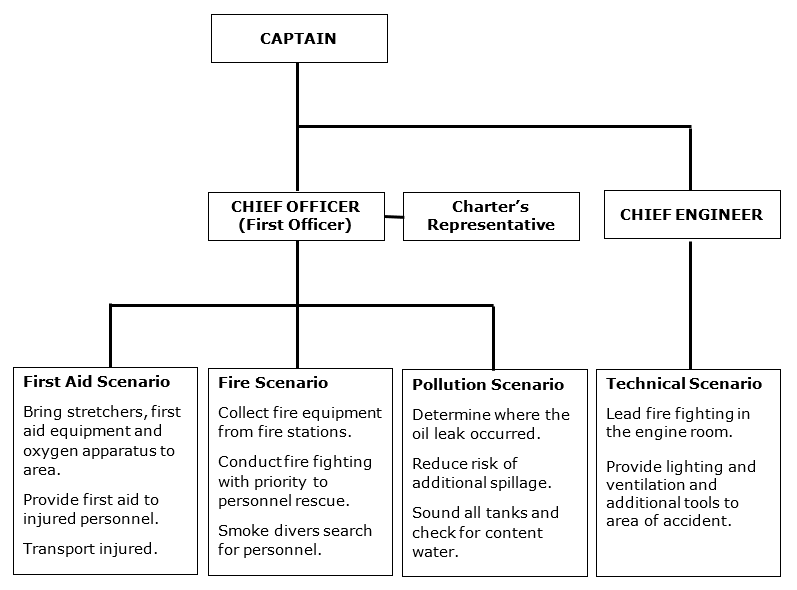
Figure 3 Example of the emergency organization on board
Exercise
Make a similar or preferably more detailed ERT of a vessel you are familiar with. Explain it to a fellow student.
Fire on board
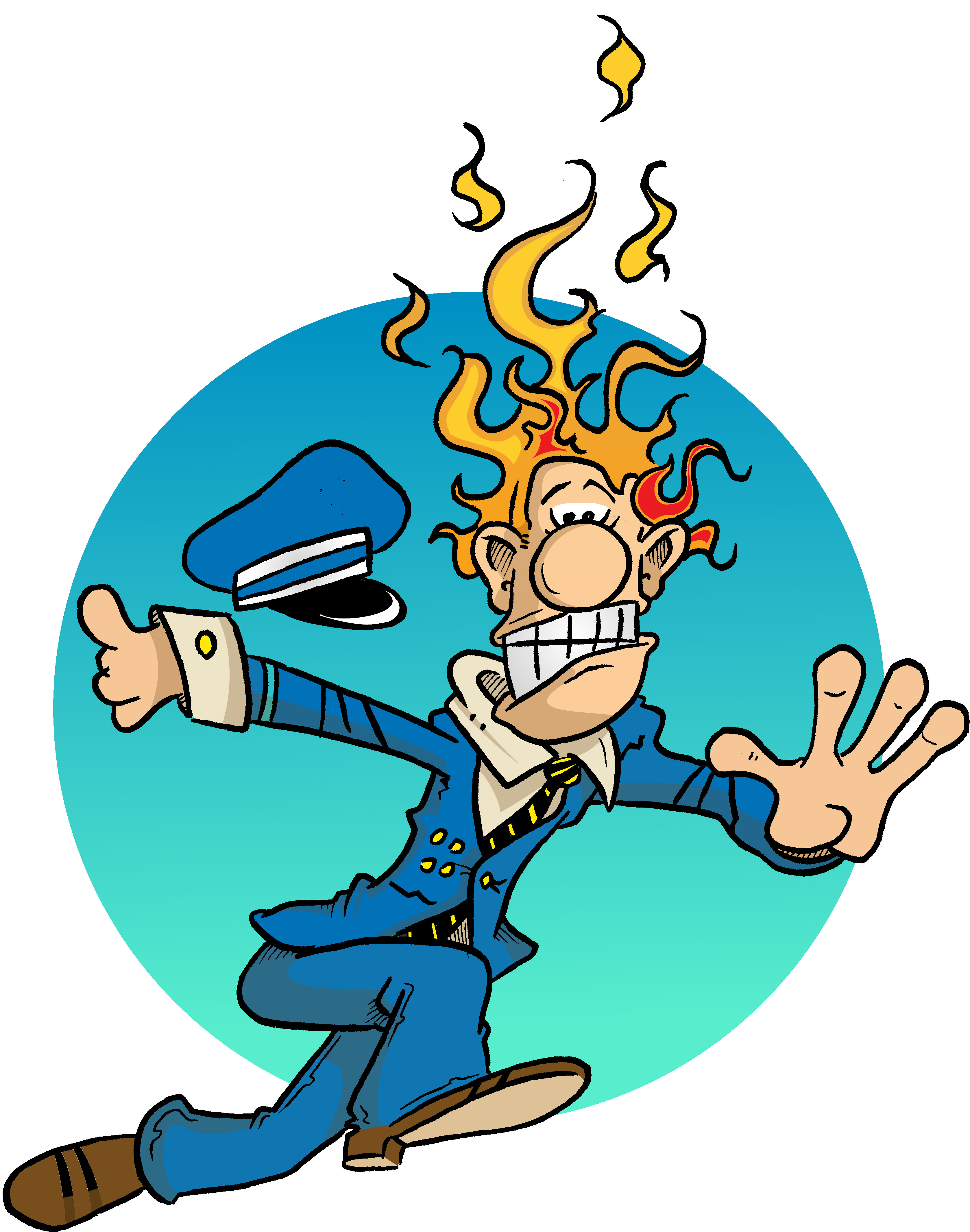
IMO has listed the following basic principles for survival in a fire:
- Knowledge of fire theory
- Regular training
- Preparedness for fire emergency
- Knowledge of danger
- Regular inspections and maintenance (IMO, 2000a)
Exercises
Get together in pairs or small groups and discuss:
- Why do you think IMO has emphasized these five principles in particular?
- Are these areas of focus on board? How?
Practical and operative training, preparedness, inspections and maintenance are all difficult to implement in this Maritime English course. Instead, the emphasis will be on practical, vocational language training and language understanding. In this section, you will see images and figures where your primary focus should be on the vocabulary used for describing the classes and chemistry of fire, different fire-fighting systems in addition to the vocabulary used in internal communication in distress standardized in the Standard Marine Communication Phrases. Through the Basic Safety and First Aid Course, and, for some, Advanced Fire Fighting and Medical First Aid Course, you get the standard training for certification the STCW sets as demand for deck officers, except English. You should, therefore, focus on enhancing your English vocabulary, making sure you, in English, can explain the basics from your previous and ongoing training.
Why the need for English, you may say? Even on board Norwegian vessels, many, if not all, of the procedures are only available in English. You are also responsible for understanding and making yourself understood in English, as are all crewmembers. Despite the demands set in place for all to have a good command of English on board, it seems many Norwegian vessels are unable to completely fulfil this requirement.
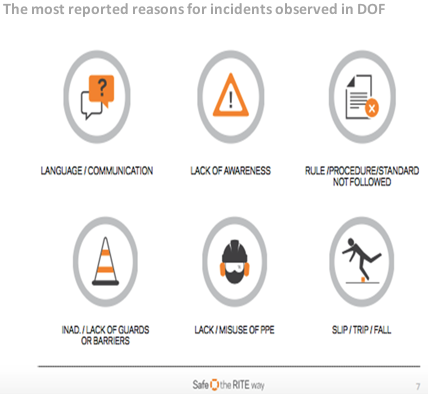
Figure 4: DOF observations
Two of the most reported reasons for incidents in the Norwegian shipping company DOF are incidents due to errors in language and communication, and incidents due to not following rules, procedures and standards, as shown in figure 4. Our focus is, therefore, communicative skills and the ability to read, understand and explain codes and procedures.
Exercises
- Do you have basic knowledge of fire theory in Norwegian? Can you explain it in English as well?
- What do you consider to be regular training? Is the term 'regular training' defined somewhere? Why do you think regular training is important?
- Explain the preparedness for fire emergency on a vessel you have worked.
- What is knowledge of danger? Can you find a definition of 'knowledge of danger'?
- Why is regular inspection and maintenance important? Is 'regular' defined somewhere?
- Group task: Discuss and share information on whether the five principles are focus areas on board. Use examples. After noting down some of key words from your discussion, one group member from each group should present their findings to the rest of the class.
Classes and chemistry of fire
Through the Basic Safety and First Aid Course (STCW A-V1/1.1-1.4), and for some, Advanced Fire Fighting and Medical First Aid Course (STCW A-VI/2.1.A-VI/4.1), you get the standard training for certification the STCW sets as a demand for deck officers, excluding English in the given courses. The support material from the mentioned course(s) should be used actively in the following section.
Teacher tip: It would be beneficial if the students have completed the basic safety course before working with this part of the chapter. Support material from the safety courses should be brought to lecture, as well as Part D Instructor Manual in Model course 2.03 Advanced training in fire fighting (IMO, 2000) where additional literature may be found. Many of the pictures/posters are from the Instructor Manual.
Recap from Science: Chemistry of fire
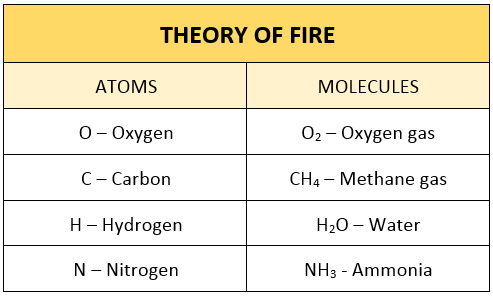
Figure 5: IMO (2000) Model course 2.03. Advanced training in firefighting, Part D: Instructors manual s, 156
In the last section, you read IMO’s list of the five basic principles for survival in a fire. The knowledge of fire theory is one of five. Therefore, it might be necessary for a quick recap of a science lesson from primary school. Because, what was the deal there again? Oxygen and a triangle or something. And where there is smoke there is fire. Or is that just a saying?
As you hopefully remember, a fire needs three elements to ignite: oxygen, heat and a combustible substance, a fuel. We have often seen these three elements in the fire triangle over the years. The later years, a fourth element has been added to basic fire theory, namely a chemical chain reaction. Simply put, the chain reaction is what happens when oxygen, heat and a fuel become a fire. This is shown in the in the figure you see below.

Figure 6: Conditions for fire
Classes of fire
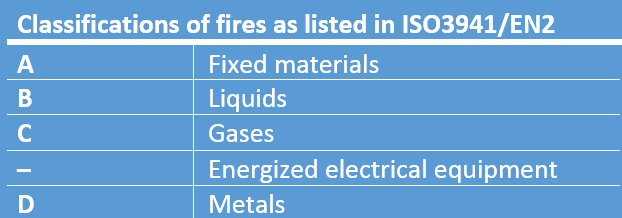
Figure 7: Classification of fires
The classification of things makes them more accessible to us. The different fire types are classified into five classes A, B, C, D, F, and are classified as ISO standard 3941. The classification is based on which combustible substances, fuels, are involved in the fire.
It is crucial to have knowledge of the different types of fire and the kinds of equipment best suited to fight these different types. Extinguishing agents differ based on the kind of fuel or substance that is involved. An extinguishing agent that proves effective on one type of fire could be dangerous when used to fight another kind of fire. A rough description of the classes are given in the following.
Class A: Combustible materials
Combustible materials are usually solid materials like wood, paper, fabic, and trash. Anything that leaves ash after being burnt up is in this category. In Class A fires, where combustible materials are the fuel, water is the preferred extinguishing agent.
US: Class A. Asia: Class A
Class B: Liquid or liquefiable solids
Flammable liquids, like oil and gasoline, and gas are liquids that both flammable and combustible. According to the European standard, flammable liquids in Class B have a flash point less than 100-degree Celsius, while a flash point above this is classified as a Class C. The preferred way to extinguish fires where flammable or combustible liquids and gas are the fuel is by using dry chemical or Halon extinguishing agents.
US: Class B. Asia: Class B
Class C: Flammable gases
Fires where flammable gasses in the form of a jet or a spray is the fuel, are in Class C. Such gasses are LPG, oxygen, and acetylene.
US: Class B. Asia: Class C
Class D: Flammable metals
Typical flammable metals that cause fire are titanium, aluminum, magnesium and sodium. In such fire, you should only use a dry powder extinguishing agent as which work by smothering the fire and absorbing the heat.
US: Class D. Asia: Class D
Class F: Cooking oil and fat
Fires where cooking oil, grease and animal fat are the fuel, are by European standard, Class F. Both foam and wet chemical extinguishers can be used on these fires.
US: Class K Asia: Class F.
Not classified: Electrical fire
An electrical fire in practice is an impossibility, as electricity does not burn. So-called electrical fires are classified, so we know what kind of fire extinguisher to use in a fire where an electrical circuit, like those that can be found in electrical systems and apparatuses, is involved. Dry powder, CO2 or vaporising liquid are preferred on electrical fires. In the Norwegian and European standard, an electrical fire does not have its own classification, while it is classified in the US and Asia.
US: Class C. Asia: Class E
Exercises
- Take turns and explain basic theory of fire to a partner.
- Get together in pairs and make an informational poster of the different classes of fire.
Areas of fire hazard
Now you know that there are multiple fuels for a fire and that the correct extinguishing method is dependent upon the fuel involved. If you think about all the compartments aboard a ship, there are many areas that are potential fire hazards. In the figure underneath, you can see some of the reasons for fire hazards in both the machinery spaces and the engine room, the accommodation, the galley and in the cargo holds. Do you agree or disagree with the information in the figure? Could you add an area or a bullet point to the already existing areas?
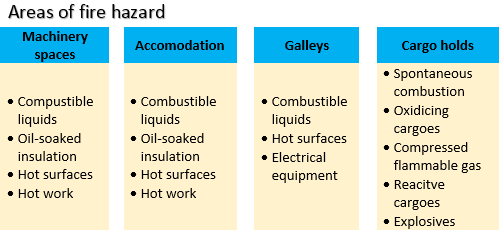
Figure 8: Areas of fire hazard
As you just saw in the figure above, there are multiple potential fire hazards in several areas on board a ship. However, one compartment stands out as potentially more dangerous than the others when it comes to fires. An investigative report ordered by the IMO Fire Safety Committee (Charchalis & Czyz, 2011), indicates that as much as 50% of all fires on merchant ships originate in the engine room. Moreover, the same paper states that 70% of these reported fire-incidents are due to oil leaks in pressurised systems.
Engine rooms on most ships are often large enclosed spaces with limited divisions and compartmentation. With narrow walkways between machinery and equipment that allow limited movement, firefighting becomes trickier than normal in this restricted and enclosed environment. Proper training in firefighting and frequent onboard exercises and fire drills are essential to both prevent and fight fires (UK P&I Club, 2017). If you think of all the different sources of both fuel and ignition in the ER, it should come as no surprise that a lot of fires originate there. You can read more about engine room fires by downloading the PDF "Risk Focus: Engine Room Fires" from UK P&I Club found here.
However, it is not only the engine room that might be the origin of a fire on board. As mentioned earlier, galleys, the accommodation and cargo holds are also typical areas where fires can occur. There are many reasons that make it essential to have a crew with fire theory knowledge and who take fire-preventative measures seriously. A properly educated crew, along with well-functioning and adequate fire protection systems, help to safeguard a vessel against the dangers of a fire on board. And this is without mentioning the loss of human life, which cannot be measured in money.
Firefighting systems
The design of the firefighting system depends on the ship type, but the system and types of fire extinguishing agents in use are generally the same on every vessel. On board ships, as in buildings, we can loosely divide firefighting systems into two general areas: passive and active systems. Active systems, like water mist systems or fire extinguishers, and passive systems, like fire doors, are crucial in preventing and fighting fires, as well as keeping them from spreading.
Passive fire protection
Bulkheads and fire doors are, as previously mentioned, passive fire protection. All bulkheads and decks are constructed to a specific standard, dependent upon the type of vessel and how to best prevent the spread of fire on board that given ship.
As we know, with help from classification, bulkhead fire resistance can be divided into three classes, A-C, defined in SOLAS regulation II-2/3 Definitions.
Class A: Prevents the passage of flame or smoke for one hour. Steel or an equivalent material are used for division, and bulkheads must be insulated approved combustible materials. The insulation is constructed to ensure that the temperature on the unexposed side does not rise 140 degrees Celsius above the original temperature or above 180 degrees Celsius at any point, within the time listed below:
Class 'A-60' - 60 minutes
Class 'A-30' - 30 minutes
Class 'A-15' - 15 minutes
Class 'A-0' – 0 minutes
Class B: Prevents the passage of flame for 30 minutes. These divisions are also preferably insulated with approved non-combustible materials, but exceptions can be made if other requirements are met. The insulation ensures that the temperature on the unexposed side does not rise over 139 degrees Celsius above the original temperature, or above 225 degrees Celsius at any point, within the time listed below:
Class 'B-15'- 15 minutes
Class 'B-0' - 0 minutes
Class C: These are divisions constructed of approved non-combustible materials. There are no requirements to meet in regards to temperature or the passage of smoke or flame.
Exercise
There are different standards for the various vessels. See if you can find the standards for fire doors and bulkheads for a specific ship type. This can also be done as a in-class group task, where the student groups compare their results.
Active fire protection
Active fire protection is both the manual and automatic detection and suppression of fires, such as fire sprinkler systems, portable extinguishers and fire alarm systems.
In SOLAS Chapter II-2/10 Firefighting, you can find the specifics for fire protection for vessels that sail according to SOLAS regulations. The UK Maritime and Coastguard Agency have guidance notes available on this section which can be accessed here . The information below is an overview of its content.
Water supply systems
Water extinguishes the fire by cooling it and is by far the most natural and widely used extinguishing agent. Through the water supply system, the vessel is provided with water in fire hydrants, pumps hoses and nozzles.
Portable fire extinguishers
The following will give you a rough overview of the different types of portable fire extinguishers. A portable apparatus is often the first line of defence in fighting fires on board the ship and should be placed where it is easily accessible.
Dry chemical
Earlier, a portable dry powder fire extinguisher was designed for a specific class of fire. Nowadays, dry powder extinguishers are filled with a mix of powders making them versatile and useful in fighting Class A, B, and C fires. These multi-purpose dry chemical extinguishers put out fires by coating the fuel with a thin layer of a fire-retardant powder. In turn, this separates the fuel from the oxygen, and the fire dies out.
CO2
Portable CO2 fire extinguishers are as its name tells us, filled with high-pressure CO2. Oxygen is, as a result of this, removed or displaced from the fire triangle, and the fire is put out. The CO2 can also have a cooling effect. The CO2 extinguishers are designed for Classes B and C.
Foam
Portable foam extinguishers are most often found in the engine room since they can smother the fire without harming the machinery. This extinguisher is comprised of two containers; the main container, which is filled with a sodium bicarbonate solution, and an inner container filled with aluminium sulphate. The two liquids mix when the plunger is unlocked, creating carbon dioxide as a product of the reaction, which again pressurises the container and the foam is forced out. (Source: dieselship.com)
The International Code for Fire Safety Systems (FSS) offers additional reading on portable fire extinguishers, but §3 is especially worth mentioning as it describes the capacity of portable fire extinguishers.
Each powder or carbon dioxide extinguisher shall have a capacity of at least 5 kg and each foam extinguisher shall have a capacity of at least 9 l. The mass of all portable fire extinguishers shall not exceed 23 kg and they shall have a fire-extinguishing capability at least equivalent to that of a 9L fluid extinguisher (FFS, 2000, §3).
Click through the picture-carousel of the different portable fire extinguishers below. Is it easy to identify which class the different extinguishers are intended to fight? And what classes are mentioned? Is this correct compared to what you just read?
Use the arrow symbols to switch between the pictures.
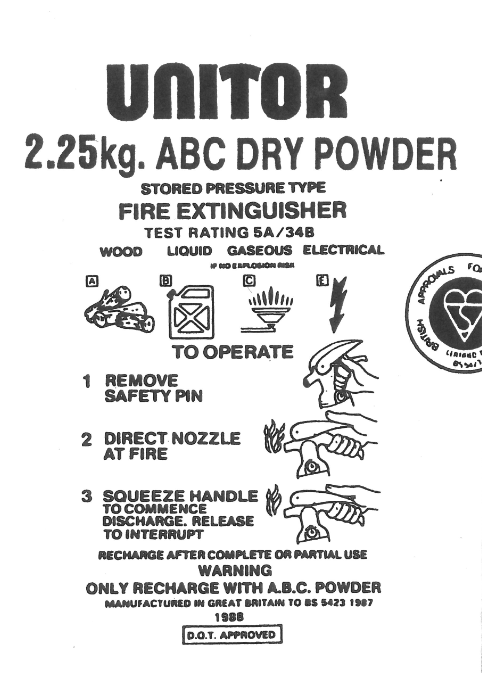
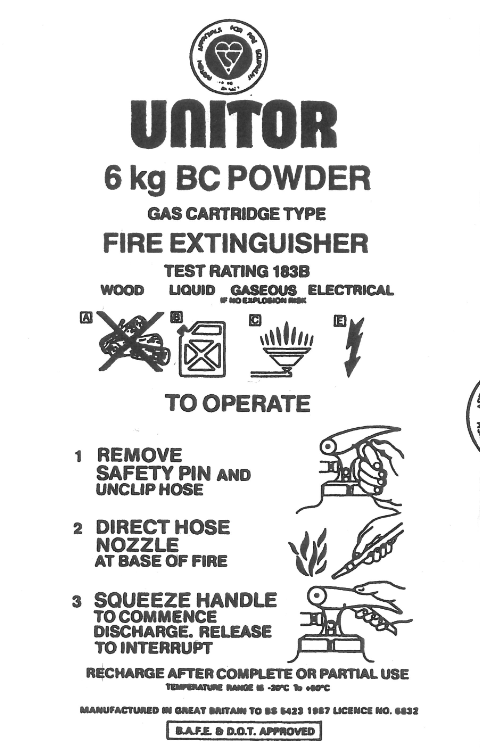
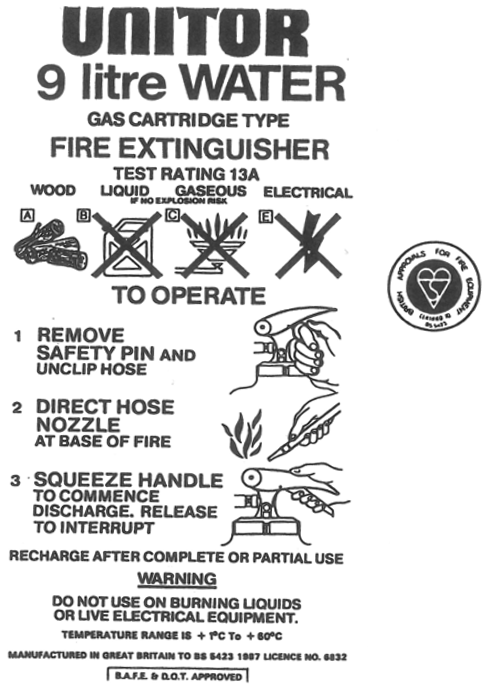
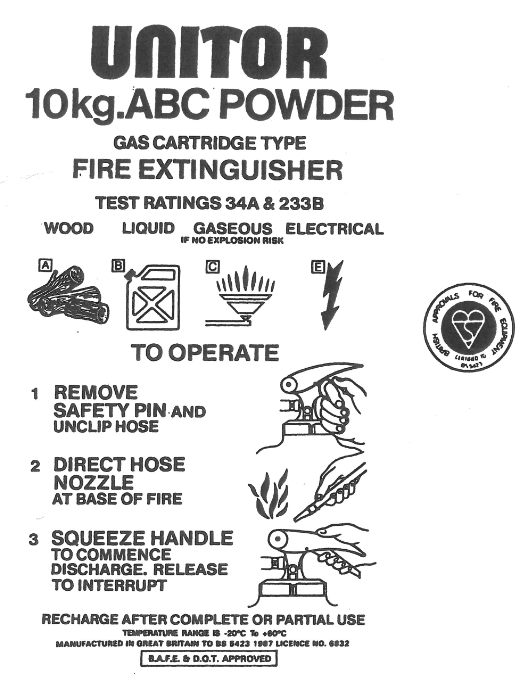

Figure 9: Picture carousel fire-extinguishing systems
Fixed fire-extinguishing systems
SOLAS II-2/10 (SOLAS, 1974) approves three different types of fixed systems. These three are
Gas fire-extinguishing system
The basic principle in a fixed gas fire-system is to fill the room or the space with gas. This gas reduces the content of oxygen in the space to a level where the fire will die. A system like this is best suited for closed compartments. In figure 10, you can see an instruction chart for the CO2 fire extinguisher system on board M/V Vancouver.

Figure 10 Marjan (2007) Fire fighting Systems onboard M/V ”Cosco Vancouver”, Instruction chart for CO2 Fire Extinguishing System, p. 7 Source: www.scribd.com
High-pressure water spraying fire-extinguishing system.
The fundamental principle in a water spraying system is that water takes away heat. The ability to remove heat, thus killing the fire, combined with the fact that ships tend to be at sea, makes water the cheapest and most available medium for extinguishing a fire on board.
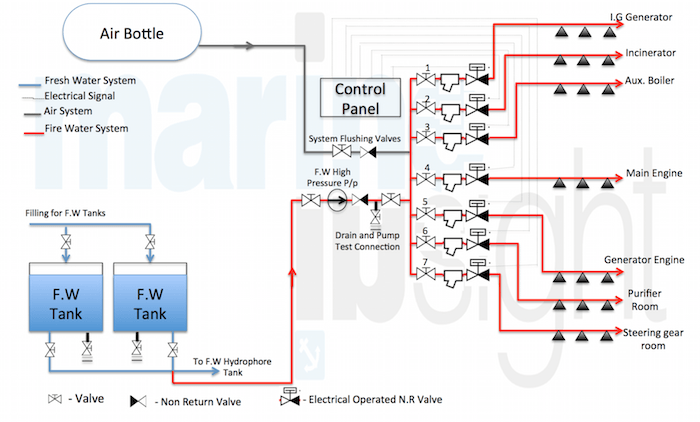
Figure 11: High pressure water mist fire-fighting system Source: marineinsight.com
High-expansion foam fire-extinguishing system
Water mixed with chemicals is the basis for the different kinds of foam fire-extinguishers. The foam is created when water mixed with chemicals flows through a pipe consequently mixing with air and thus causing the water to work as a coolant. This foam can fill entire rooms or spaces causing minimum harm to instruments and equipment.
You can learn more about HP foam systems here .
In the following table, you can see an overview of types of fires and what extinguishing agent to use.
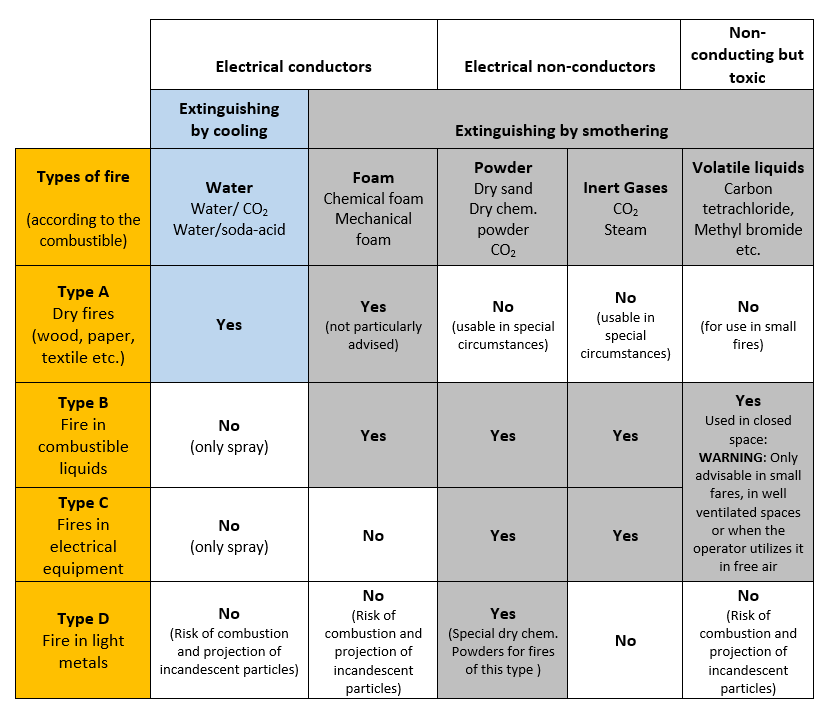 Figure 12: Fire fighting systems
Figure 12: Fire fighting systems
In the International Fire Safety System Code, FSS, which sets the standards for the specifications of vessels in compliance with SOLAS, you can read more about the different systems. You find the FSS Code here.
Moreover, in SOLAS II-2/10 Fire fighting (SOLAS, 1974) you can also find the specifics of fire-extinguishing systems in the different departments and areas of the vessel, like the engine room, cargo spaces, the accommodation and control stations, along with the regulations for fire-fighters’ outfit on the different type of vessels. SOLAS is found here.
Underneath you see a table, figure 13. In this table you can see what type of extinguishing medium best suited for different types of fires.
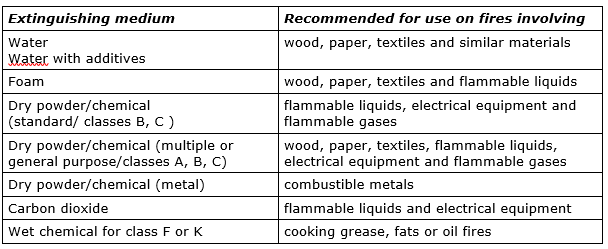
Figure 13
Exercises
- Read through an article in either SOLAS II-2/10 or part of the FFS Code. Attempt to ‘decode’ the legal language. Which verbs can you identify? Can you interepret what is meant by the various modal verbs (verbs like will, shall, can, may, must, etc.) used? Review the “Know the law” (hyperlink) section in Chapter 2 to refresh your memory.
- Quiz cards
Make three different quiz cards with the following keywords:
Place of fire origin:
Fuel:
Preferred extinguisher agent(s):
Take turns quizzing a partner by giving them a keyword you have written on your quiz card and asking them to give you the missing information
Systems and appliances like the ones you've just read about are in constant need of up-keep. Each ship has its procedures on how and when firefighting systems are maintained and tested, likewise for life-saving appliances. In the figure below you can see Lloyds's Register guidance notes on the summary of SOLAS requirements for maintenance, servicing, testing and drills.
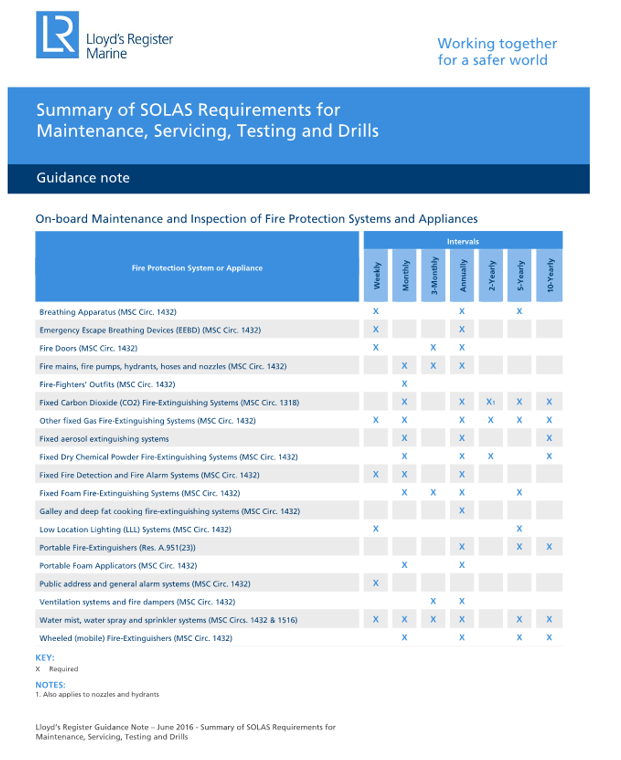
Figure 14: Requirements for on board maintenance and inspection of fire protection systems and appliances
In addition to these active fire-fighting systems, you also have smoke, heat and fire-detectors, and of course lifejackets, life rafts and other life-saving equipment needed to satisfy the current regulations. In the document Common personal protection equipment and life-saving appliances on board a vessel you can find a list and an exercise.
Extended exercises
-
Informational poster and screencast presentation
Use the table in figure 12 to add the correct type of extinguishing agent in the table you made in Classes of fire, Exercise 2. Turn it into an informational poster. Add pictures or figures where needed.
Make video presentation with a screencast software where you explain the different fire classes and the appropriate fire extinguishing agent. -
Virtual video group task
In a group, make a video presentation about one of the following fire systems. Each group must have a different system essentially creating a compendium of informational videos that demonstrate their English competency on the topic of fire-fighting systems.
a. Bulkheads and fire doors
b. Fire hydrants
c. Fire pumps
d. Fire hoses and nozzles
e. Portable fire extinguishers
f. Gas fire-extinguishing systems
g. High-expansion foam fire-extinguishing system
h. High-pressure water spraying fire-extinguishing system -
Instructional speech
An apprentice cadet has joined your crew. He is rather inexperienced and speaks only English. You have been given the task of training him in onboard fire safety.
Using your prior knowledge about onboard fire safety and what you have just read, write a text in the form of an instructional speech that demonstrates how you would train the new crewmember. This “speech” will be given during a tour of the ship (your choice), where you will show the trainee all the important fire prevention and fighting devices.
Include any and all information you consider to be important for the new trainee to know and refer to any important regulations that are relevant for fire safety on board.
!!! tips "Tell a Tale"
Fortunately, a day at work is predictable on board, and even if at times something out of the ordinary happens, it tends to work out for the best without major accidents. Below, first engineer Marius Hauge gives an example of a day to remember.
For the most part, daily operation is quite similar for most engine rooms at sea. Everyone has their responsibilities and duties as daily routines, propulsion and maintenance. Of course, there is a difference in the daily operations on board a PSV and an ATHS vessel, and subsea vessels stand out, too. Some have towers for well stimulation, trenchers for cable laying; others offshore cranes and ROVs for varying subsea jobs. I work at the latter, and I can safely say that in this profession one hardly has time to get bored.
I want to tell you a story a bit out of the ordinary. One late summer, we received a contract with an oil company for a special mission: Observation and destruction of an object located in an unfavourable location for the oil company. It is not uncommon to find unidentified objects on the seabed after much illegal dumping over the years, as well as World War II items in the North Sea Basin. It was of course “a secret mission” at the time. One has an obligation to maintain secrecy in this line of work, which all must adhere to while on board a vessel. Sosial media has become such a problem for many that all employees must sign confidentiality agreements prohibiting the use of social media on board. Even a few harmless pictures or status updates on Facebook could be devestating for the company/job at hand/etc. All contact with the media should go through the proper channels and if one does not comply with this, it can lead to serious consequences both for the company and employees.
The course was now set to a given point in the North Sea and we attended the briefing. The picture that met us on the projector wall was, to put it mildly, shocking. A mine. The mine was a moored mine from WW2 which over time had gotten loose from where it was anchored and was slowly drifting northward. The mission was to move the mine using an offshore crane and a specially designed mesh to tow it away from the location before destruction by explosive. An ROV placed the explosives, our vessel pulled away, and we were ready for the detonation. We all agreed that this was going to be a spectacular week and a memory for life.
The mine expert meant that, by his calculations, there would hardly be any explosives left after all those years; The explosives would have little effect.
After some intensive days of careful manoeuvring by both boat, crane and ROV, we had finally moved the mine far enough. A few kilograms of C-4 (plastic explosive) was wrapped and placed below the mine via the arms of the ROV. I can with all certainty tell you that the ROV pilot sweated a little more than usual on this day, when a small error handling the C-4 could possibly trigger the potentially explosive mine causing great damage to the hull and the ROV. Luckily, everything went according to plan and the second to last phase of the mission was over.
At 09:00 the next morning, all departments were ready for the extraordinary Tuesday we had been waiting for. The wildlife representative listened for whales and other marine life in the area with his special equipment and microphones. Green light, thumbs up. The countdown started. 3-2-1. Detonation.
....
Even several hundred meters from the mine, we heard a violent and deep blow in the control room. The intensity and force of it was surprising for both the crew and the guy with the calculator, not to mention the poor bastard who had forgotten to take off his headset as he listened for marine life. It slammed so violently that all phones on both A and B deck started to ring. The shock wave was clearly visible on the surface. The mine, which was well over 70 years old, still had its absolute maximum explosive effect. The mission was a success and everyone involved felt the relief of a job well done.
The wildlife guy hopefully is back to normal heart rhythm and hearing, but unfortunately I cannot verify that.
Drills: Fire and abandon ship
Both abandon ship drills and fire drills are covered in SOLAS’ Chapter III Regulation 19. The regulation starts by saying that it applies to all ships, and further stating that every crew member with assigned emergency duties shall be familiar with the duties before the voyage begins.
Article 3, Drills, states that
3.1 Drills shall, as far as practicable, be conducted as if there were an actual emergency.
3.2 Every crew member shall participate in at least one abandon ship drill and one fire drill every month. The drills of the crew shall take place within 24 h of the ship leaving a port if more than 25% of the crew have not participated in abandon ship and fire drills on board that particular ship in the previous month. When a ship enters service for the first time, after modification of a major character or when a new crew is engaged, these drills shall be held before sailing. The Administration may accept other arrangements that are at least equivalent for those classes of ships for which this is impracticable.
3.3 Crew members with enclosed space entry or rescue responsibilities shall participate in an enclosed space entry and rescue drill to be held on board the ship at least once every two months (SOLAS, 1974 §III/19-3)
Exercise
In your own words, a simplified version of what SOLAS says about drills.
The content of abandon ship drills and fire drills are covered as follows in SOLAS:
3.4 Abandon ship drill
3.4.1 Each abandon ship drill shall include:
.1 summoning of passengers and crew to muster stations with the alarm required by regulation 6.4.2 followed by drill announcement on the public address or other communication system and ensuring that they are made aware of the order to abandon ship;
.2 reporting to stations and preparing for the duties described in the muster list;
.3 checking that passengers and crew are suitably dressed;
.4 checking that lifejackets are correctly donned;
.5 lowering of at least one lifeboat after any necessary preparation for launching;
.6 starting and operating the lifeboat engine;
.7 operation of davits used for launching liferafts;
.8 a mock search and rescue of passengers trapped in their staterooms; and
.9 instruction in the use of radio life-saving appliances (ibid.)
3.5 Fire drills
3.5.1 Fire drills should be planned in such a way that due consideration is given to regular practice in the various emergencies that may occur depending on the type of ships and the cargo.
3.5.2 Each fire drill shall include:
.1 reporting to stations and preparing for the duties described in the muster list required by regulation 8;
.2 starting of a fire pump, using at least the two required jets of water to show that the system is in proper working order;
.3 checking of fireman' s outfit and other personal rescue equipment;
.4 checking of relevant communication equipment;
.5 checking the operation of watertight doors, fire doors, fire dampers and main inlets and outlets of ventilation systems in the drill area; and
.6 checking the necessary arrangements for subsequent abandoning of the ship.
3.5.3 The equipment used during drills shall immediately be brought back to its fully operational condition and any faults and defects discovered during the drills shall be remedied as soon as possible. (ibid.)
Muster list
The muster list mentioned in §3.4.2.1 and §3.5.2.1 shows the procedures and duties of all personnel in an emergency situation. The list should be displayed in prominent areas of the vessel to ensure that it is made available for every member of the crew. Muster lists are often found on the bridge, in the engine room, the accommodation, the galley, and alleyways. An example of an emergency plan or muster list can be seen below.
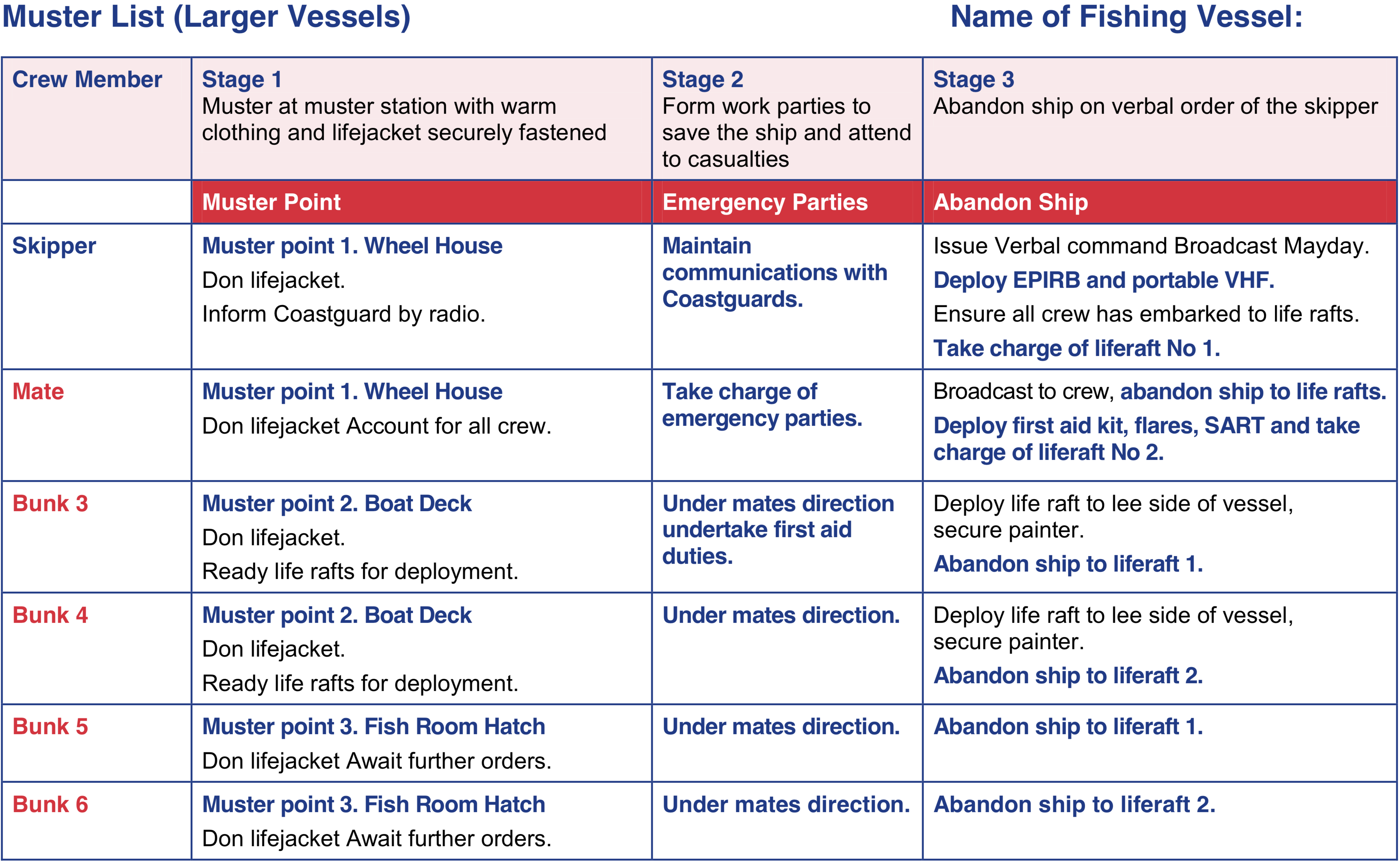
figure 14: muster list
Procedure examples
In the following, you will see three different examples of procedures. The first, figure 15, is an example of a procedure for fire and major damage. The second, figure 16, is a procedure example for onboard rescue actions, like minor fires, personell injuries and rescue operations in tanks or holds. Both of these procedures are examples from the Norwegian shipping company DOF. The last one is a more generic example of a fire procedure.
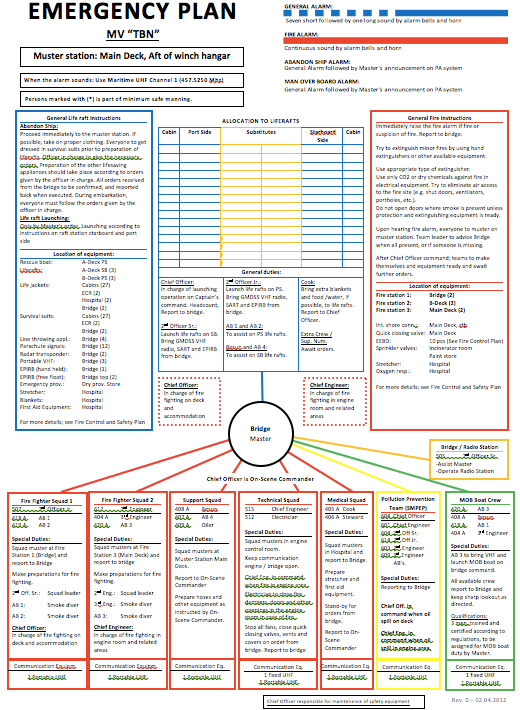
Figure 15 Procedure example: Emergency Plan/muster list
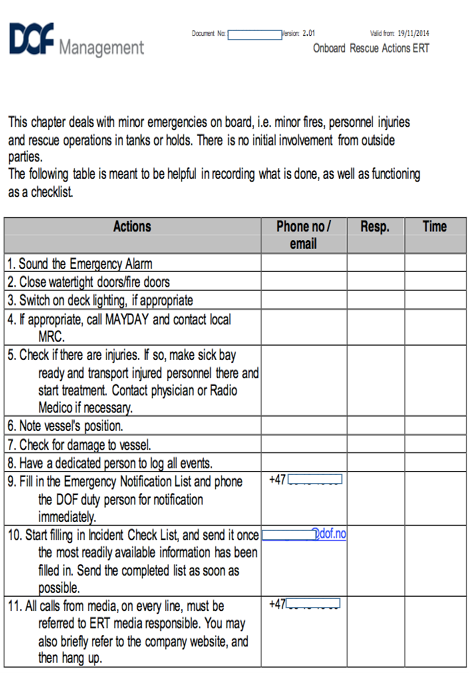
Figure 16 Onboard Rescue Actions ERT
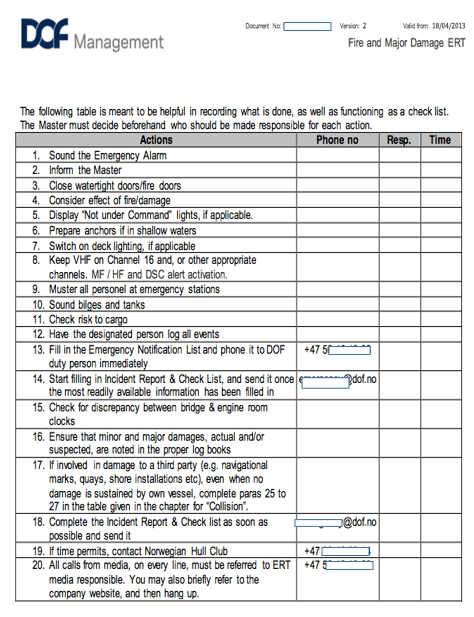
Figure 17 Fire and major damage ERT
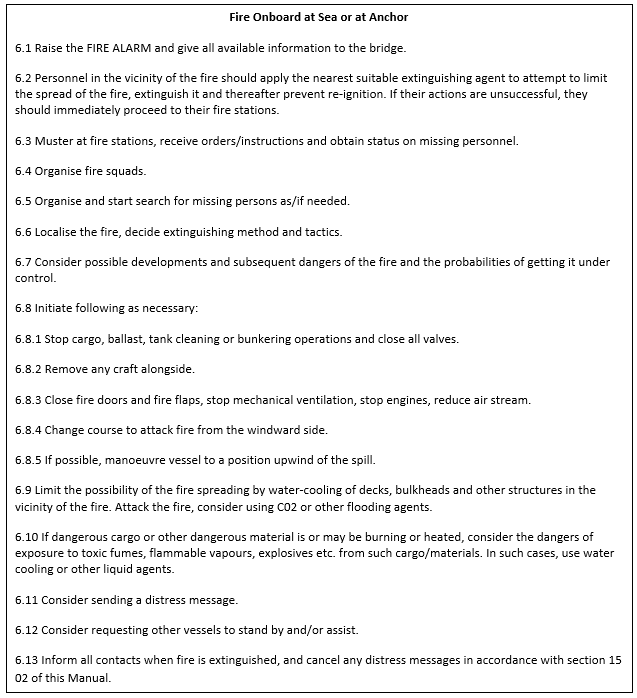
Figure 18 Procedure example: Fire Onboard at Sea or at Anchor
Abandon ship drill
3.3.1 Each abandon ship drill shall include:
.1 Summoning of passengers and crew to muster stations with the alarm required by regulation 6.4.2 followed by drill announcement on the public address or other communication system and ensuring that they are made aware of the order to abandon ship;
.2 Reporting to stations and preparing for the duties described in the muster list;
.3 Checking that passengers and crew are suitably dressed;
.4 Checking that lifejackets are correctly donned;
.5 Lowering of at least one lifeboat after any necessary preparation for launching;
.6 Starting and operating the lifeboat engine;
.7 Operation of davits used for launching liferafts;
.8 A mock search and rescue of passengers trapped in their staterooms; and
.9 Instruction in the use of radio life-saving appliances (SOLAS, reg. 19.)
Exercise
Read thoroughly through one of the procedures, and let a partner quiz you. Try explaining the procedure to a partner as best as you can.
Standard Marine Communication Phrases
In distress and emergency situations it may be a matter of life and death that messages are precise and unambiguously given and received.
As you read in chapter one, IMO requires under the STCW, the ability to use and understand the Standard Marine Communication Phrases (SMCP), for the certification of officers in charge of the navigational watch on board ships of 500 GT and more. The SMCP has been compiled, amongst other reasons, to assist in the greater safety of navigation and of the conduct of the ship. If you need a reminder on the background of these communication phrases, click here (link tilbake til kap. 1)
The SMCP is divided into external and internal communication. Part A covers phrases that are to be used in external communication while Part B focuses on standard safety related pharses used on board.
As for distress and emergency situations, you should be familiar with the following parts of the Standard Marine Communication Phrases:
A1/1: Distress communication
A1/2: Urgency traffic
B2: Safety on board
B4: Passenger care
It is recommended that you purchase Maritime standarduttrykk which offers SMCP in both Norwegian and English. IMO's own publication of SMCP is also available, and the phrases can be found here as well.
Exercises
- Instructions to passengers in the event of an emergency**
In pairs: Write some of the procedures/SMCP’s on a piece of paper. Draw a paper and give the instruction to your partner. Take turns. - Write a summary about the Costa Concordia accident. Include details leading up to, during, and after the incident.
Refer to SOLAS annexes that were violated or not observed. Include what the annex actually states and how it was violated. Conclude your summary with recommendations and procedures that would help prevent an accident like this in the future.
The following links could be helpful in writing your summary:
BBC “Costa Concordia: What happened?”
Costa Concordia full accident report
Saftey4Sea summary of the causes of the accident
Costa Concordia “Terror at Sea” documentary
In this chapter, you have learnt...
- why the ISM-code is important
- about classes of fire and different fire fighting systems
- how to execute abandon ship drills and fire drills
- internal communication in emergency situations
Bibliography
- Charchalis, A. & Czyz, S. (2011). Analysis of fire hazard and safety requirements of a sea vessel engine rooms. Journal of KONES Powertrain and Transport, Vol. 18, (No. 2). Retrieved from: https://pdfs.semanticscholar.org
- Dieselship.com (n.d) Foam fire extinguishers. Retrieved from: https://dieselship.com
- IMO (2000a) Model course 2.03 Advance training in fire fighting. (The A after 2000 needs to be added. In the other 2000 a B needs to be added)
- UK P&I Club (2017). Risk Focus: Engine Room Fires. Risk Focus: Consolidated 2017. Retrieved from: https://www.ukpandi.com
- DOF. (2016a, December 13). dof.no. Safety starts with you. Bergen, Hordaland, Norway: DOF. Retrieved Desember 2016, from dof.no
- dieselship.com
- Charchalis & Czyz, 2011
- Norwegian Maritime Authority . (2014, September 5). sjofartsdir.no. Retrieved December 16, 2016, from sjofartsdir.no
- International Maritime Organization (1997). International safety management code (ISM code) and guidelines on the implementation of the ISM code. London: International Maritime Organization.
- IMO (2000) Model course 2.03 Advance training in fire fighting, Part D: Instructors manual
- Lloyds Register Marine (2016) Summary of SOLAS Requirements for Maintenance, Servicing, Testing and Drills.
- Marjan (2007) Fire fighting Systems onboard M/V ”Cosco Vancouver”, Instruction chart for CO2 Fire Extinguishing System
- IMO (2000) Compendium for Model course 2.03 Advanced training in fire fighting
- UK P&I Club, 2017

